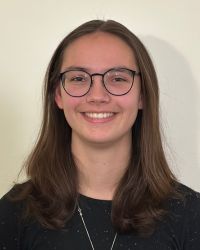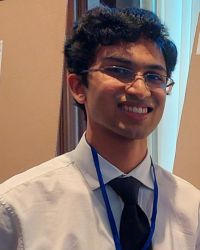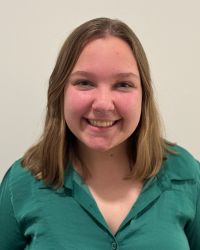Tomorrow (Dec. 8), more than 390 undergraduate students at Case Western Reserve University will take to the Veale Convocation, Recreation and Athletic Center to present their research and creative projects at Intersections, a poster session hosted by the Undergraduate Research Office.
Held each semester, the event is an opportunity for students to share the array of academic work they’re conducting with the academic community, which spans all disciplines—from arts and humanities to engineering, life sciences, physical sciences and social sciences.
“Intersections is one of our university’s big celebrations of undergraduate researchers and their faculty mentors,” said Sheila Pedigo, director of undergraduate research. “For students interested in getting involved in research, it’s a great way to talk to a lot of undergraduates about their work and how they got involved in research. For students who soon may be working on their capstone projects, there are 160 capstone projects featured.”
To get a glimpse of what attendees can expect, The Daily sat down three students who will present their work. Read on to learn more about their projects—and make a plan to attend Intersections between 11:30 a.m. and 2 p.m. tomorrow.
Jessica Furlough

Jessica Furlough is a fourth-year student studying biology and environmental studies. Furlough’s presentation is titled “Rhododendron exposure to the pathogen phytophthora cinnamomi in the presence and absence of ericoid mycorrhiza.”
Q: Tell us about the project you’re presenting.
A: My project looks at a rhododendron shrub and the impacts of a pathogen in the presence and absence of an ericoid mycorrhiza. Mycorrhizal fungi form a mutually beneficial relationship with the roots of plants. The type of fungi I worked with associates with the plant inside the roots and helps with nutrient and water intake in exchange for sugars from the plant.
My study looked to see if this relationship helped the plant survive and grow when exposed to root rot, a widespread disease. This relationship has the potential to be applied as a bio-fertilizer to help protect crops or ecosystems from this disease.
Q: What did you enjoy most about working on this project?
A: My research took place in the greenhouse at Squire Valleevue and Valley Ridge Farms where I went for censusing data and harvesting the plants at the end of the experiment. The potting and planting also took place at Holden Arboretum. Being able to visit these places was a lot of fun.
Over the summer, I also got to learn about other research projects at associated sites, which definitely was my favorite part about working on this project.
Q: Why do you believe students should get involved with Intersections?
A: Intersections is a great way to get practice in speaking about your research. It is also a great opportunity to see projects in and outside your field and engage with fellow students.
Aman Kapoor

Aman Kapoor is a fourth-year student studying physics and minoring in biology, chemistry and biochemistry. Kapoor’s presentation is titled “High-pressure single-molecule investigation of analyte interactions with chiral stationary phase particles.”
Q: Tell us about the project you’re presenting.
A: Our lab studies chromatography, which is a technique used to separate different components of a mixture and is very important to pharmaceutical development.
Chromatography is, in theory, a powerful technique, but in practice, it is extremely inefficient and expensive. The Department of Energy estimated we waste $4 billion in energy costs annually in inefficient chromatographic separations. This is mainly because the process to choose the right separation materials and conditions is entirely empirical and is not informed from the molecular scale. Scientists and engineers looking to do a chromatographic separation have to go through a long series of top-down, empirical testing to find the right conditions.
Our lab is working on studying chromatography at the single-molecule level. We have home-built, single-molecule fluorescence microscopes that use lasers, high-power optics, and super-resolution post-processing algorithms to image separations at ~10s of nm of resolutions—which is underneath the diffraction limit of light. We have published work that studied industrial stationary phase particles at the single-molecule level and showed how particle coatings hindered particle porosity.
But the work that we’ve done was at relatively low pressures (~600 psi), whereas actual industrial separations are at around ~5,000 psi. Single-molecule studies are conventionally at low pressures given how fragile most of our optics equipment is. My project is about building a single-molecule set up to study chromatography at high pressures.
Q: What did you enjoy most about working on this project?
A: I’ve enjoyed learning from a really collaborative group of researchers. The project is quite multidisciplinary, and I’m constantly exposed to new ideas and equipment. Building a high pressure single-molecule setup involves a lot of chemistry, since I have to prepare fluorescent dyes for imaging and dissolve and pack the stationary phase materials into thin capillary tubes compatible with fluorescence microscopy. I also get to work with lasers, optics, and imaging algorithms for the microscopy aspect. There’s also a huge engineering component of the project—I have been building a high-pressure fluid flow system for the set up, which has been an amazing learning experience.
The work has been really collaborative, and I’ve had the opportunity to learn from a lot of different people. In addition to working with a PhD student mentor and my PI, I also had the opportunity to collaborate with the Nesbitt Lab at University of Colorado Boulder and learn about a similar set up they built for an entirely different application. I’ve also been working with our lab engineer for the design aspect, and he has taught me a lot about CAD and machining.
Q: Why do you believe students should get involved with Intersections?
A: I think many people agree that one of the best measures of knowing something well is the ability to explain things to others. Intersections is the perfect opportunity to explain your project to the community, answer important questions, and get collaborative ideas. Going through the process of designing a poster and explaining your project will make you a better researcher and will also be excellent preparation for grad school/job interviews.
Abagayle Omlor

Abagayle Omlor is a fourth-year student studying psychology. Omlor’s presentation is titled “The consequences of weight stigma in healthcare settings.”
Q: Tell us about the project you’re presenting.
A: My project is a comprehensive literature review about the consequences of weight stigma in healthcare settings, specifically diminished doctor-patient relationships, feelings of guilt and shame, and disregard for the patient’s presenting problem. These consequences lead to healthcare disparities for overweight patients, including increased rates of healthcare avoidance, worse quality of treatment, and overall worse health outcomes.
Q: What did you enjoy most about working on this project?
A: Since my project is a literature review, the majority of my time working on this project was reading research paper after research paper. Fortunately, I found this topic as a whole really interesting, so I really enjoyed delving into the literature behind it.
My favorite papers to read were the qualitative sources that I used. It was incredibly powerful to hear about patient experiences with weight stigma using their own words.
Q: Why should students get involved with Intersections?
A: Intersections because it’s a great opportunity to share your hard work with a much wider audience. We put so much time and energy into these research projects, and it would be a shame for them to be presented to our class or small research groups only. Intersections allows us to reach so many more people and share all of the hard work that we have put in throughout the semester.


